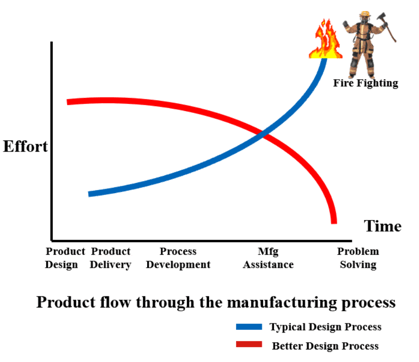
Launching a new product or producing new parts for your customer’s launch is an exciting time for any manufacturer. You could be diversifying your offerings or you may be going after new customers or markets, and it can potentially change your whole brand.
But that's probably the most important thing to recognize at this point: things are changing.
Profitable manufacturing requires repetitive processes, predictable outcomes, and a fairly linear workflow structure. But product development isn't like that. There's not an established process, multiple stakeholders are involved, and information can reside in many places at once.
So, if you're launching a new product, you'll need to manage the support behind that product to be successful. Without the right support, your new product could fail and cost you massive amounts of time and money.
Here are some tips to make your product development process better and more efficient. Plus, we'll tell you how this process can qualify for the R&D tax credit.
Take your time
Product development is a complicated process without a linear path forward. Tasks may simply take longer than expected, and while maximum efficiency is always the goal, pushing to keep your teams working at 100 percent capacity simply won't work.
Give your product development team the time they need to fully work through the challenges they face. Give them space to try things out, and then go back and fix them if something isn't right. Rushing people and putting too much on their plates won't help anything, and it could actually end up costing you more down the road.
Monitor and document engineering design, tool building and processes as these activities likely qualify for R&D tax credits.
Think smaller
When producing the components for your new product, do so in small batches to reduce queuing. This may seem counterintuitive to manufacturers who see bulk as a shorthand for efficiency and savings. However, limiting the size of your production batches can actually help your product testing personnel be more efficient while reducing the number of defects in your components thus reducing cash spent on materials.
As you're creating manufacturing processes for these components, keep track of any custom production set-up activities as these may qualify for an R&D tax credit.
Remember, keep your dreams for the new product big, but make sure the batches stay small.
Plan for changes
Product development is a dynamic process, and no matter how good you think your production plan is, it will likely change along the way. And that's OK.
Too often managers try to stick to their original plans even as the scope of the project or product requirements are changing. Attempting to put a square peg in a round hole will only put undue stress on your product development team and create yet more challenges for them to work through. If something isn't working or the target outcomes change, be prepared to change right along with them.
Manage your timeline
Achieving the most successful outcome for your new product development project will likely come down to how you utilize the resources at your disposal. As we mentioned before, you need to give your team time and space to work through the process. But this also means being aware of all the projects in your pipeline. Just because you have some downtime doesn't necessarily mean the time is right to start a new project.
Before you start any project, make sure you have the resources to see it all the way through. Pulling personnel off one project to finish another will make their work less efficient and put other projects at risk.
Don't be afraid to fail
The complexity of product development almost guarantees that not everything will go exactly to plan the first time around. Failure is often part of the process and the R&D tax credit rewards you for failure. As a manager, you have to accept and expect this, and not demand that your team get everything perfect on the first try. By giving them room to fail, and being supportive when that happens, you can increase the likelihood of achieving success in the end.
Supporting new product development is a difficult task for any manager, especially when expectations and pressures are high. But by following these steps and avoiding the most common mistakes, you can increase the efficiency of your teams and ultimately achieve a profitable new product launch.






